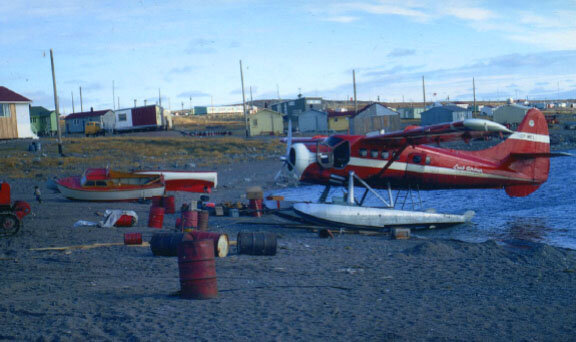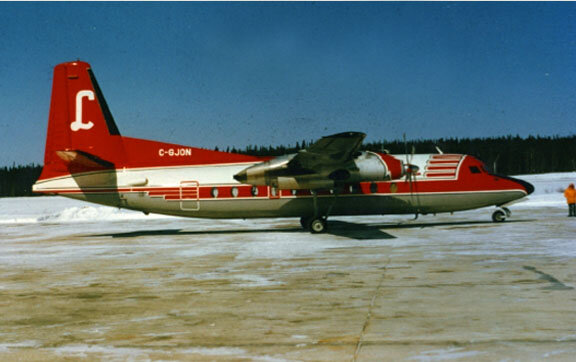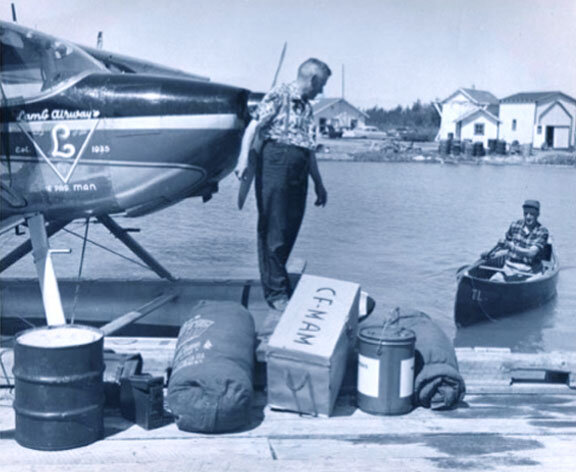IT’S A NICE DAY FOR FLYING — the Jack Lamb Story
On his final morning, Jack Lamb's nurse walked to the window in his hospital room and threw open the blinds to a bright, sunny, crisp and cold Manitoba morning and exclaimed, "It's a nice day for flying, Jack.” It was the kind of day that Jack and his 5 brothers rejoiced in throughout their lives – CAVU - clear above, visibility unlimited. It was the kind of day that was good for business, good for pilots and good for the North. It was a perfect day for Jack Lamb to leave this world for the next... and he took the opportunity.
The great sweep of the Canadian North lay largely unreachable and uninhabited up until the coming of the aeroplane. Small isolated communities clinging to existence beneath thousand foot cliffs at the very edge of the Arctic Ocean remained just that - isolated outposts. In the far North, small bands of Inuit could survive only by remaining as small bands separated by huge distances - for the land and its food sources could only support so many people. The most isolated groups living in tiny coastal villages wintered through with the hopes of an early spring and the arrival of a supply ship once the ice was gone. Getting in to one of these communities meant staying there for a long time before getting out again. Only hardy southern souls and First Nations people (who knew how to live with and on the land) could survive and flourish. Thousands of years of unchanging rhythms changed almost overnight with the coming of a new kind of transportation - the aeroplane. Distances that took weeks to travel by foot, sled or canoe now were spanned in a matter of hours. Supplies could be brought in throughout the year, products could be flown out and people brought out to hospitals. Life was always good in the North, but with the advent of the aeroplane, it was now becoming easier.
The first few aerial steps were tentative at best - there were no runways, no fuel caches, no navigation systems, hardly any maps and the Global Positioning System wasn’t even in the minds of science fiction writers. The opening up of the North (and it truly was an opening) was done with cloth and metal wings, rough-made skis, frozen body parts and hard dangerous work. It was done by men who were hard workers first and aviators second. The few that survived the first years would grow to operate across the North and all would become legends. It is no coincidence that many of these companies were named not for some sad marketing concept like Tango or Zoom or Jazz, but for the very men who put their strong backs and reputations on the line for the success of the enterprise – airlines like Max Ward’s Wardair, Jack and Chuck Austin’s Austin Airways, Russ Bradley’s Bradley Air Services, Arthur Fecteau’s A. Fecteau Transport Aerien and of course Tom Lamb’s Lamb Airways.
Jack Lamb flying a Lambair de Havilland Canada Otter en route to remote Arctic Bay on Baffin Island. Insets: a Lamb Airways luggage sticker and a set of Lambair pilots wings. Photos from Lamb Family Archive
Tom Lamb (left), the pioneering patriarch of the Flying Lambs and his flock - his six sons. Left to right after Tom are Greg, Donald, Dennis, Jack, Doug and Conrad. Photo from Lamb Family Archive
Not only did it take great effort and fortitude to build an airline like Lamb Airways, it took lots of imagination too. The airline's creative slogan says it all - "Don't Ask Us Where We Fly, Tell Us Where You Want to Go". Here a Lamb Airways Norseman takes the Kowmuk family on a trip from Sandy Point. Photo: Lamb Family Archive
Related Stories
Click on image
Jack Lamb
Jack Lamb was born April 12, 1934 at Moose Lake, Manitoba, to Tom and Jennie Lamb. He was the seventh of nine children born into the soon to be famous aviation family. At the time, Tom owned a Stinson floatplane and was considering turning it into a more serious business. A year later he founded Lamb Airways and so began a life-long passion for aviation and northern development, not just for Tom, but for his entire family. With the growth of Lamb Airways, Jack and his five brothers fell under the flying spell, and all would spend the rest of their lives in and around aviation. Through the 1950s and 1960s, Jack was associated with many of the major projects in northern Manitoba and the Arctic, working to develop the Canada of today. His life in aviation included many adventures that he loved to chat about with his friends... and if you met Jack, you were automatically his friend. One of his favourite stories was about his trip to Afghanistan where he recovered a Douglas C-47 Dakota and the eventful return flight to Manitoba across the North Atlantic. Then - his continued adventures with DC-3 CF-DBJ, including the time he and his crew had to salvage it when it sunk through the ice in a northern lake (see below).
Jack was a past director of the Air Transport Association of Canada, and the Western Canada Aviation Museum. He was also the recipient of the 1967 Canada Confederation Medal, and the WCAM Pioneer in Canada Award in 2000. In 2007, Jack, his father and his brothers were recognized with an award of appreciation for their dedication and service to the development of Nunavut, the third great Canadian northern territory carved from the vast expanses of the Northwest Territories. In 2008, the Manitoba Aviation Council honoured Jack and his brothers for their contribution to Manitoba's history. Jack was very proud of the fact that his father, Tom, was recognized by the readership of the Winnipeg Free Press as one of the "Greatest Manitobans" for his efforts to improve life in Manitoba's north.
"Never land on the black ice." So admonishes the Lambair family website several times. In this case a Lamb Air DC-3 (CF-DBJ) has fallen through rotten ice of Tadoule Lake, Manitoba in late May of 1975. Jack's wife Barbara supplied the vacuum cleaner which is blowing air to inflate airbags beneath the wings to lift the Dak above the ice surface. Photo: Lamb Family Archive
Jack Lamb, at the controls of the DC-3, taxies the beast on a plywood road to clear the rotten ice before taking off for Thompson, Manitoba. In the background on the ice can be seen one of the deflated airbags that lifted the Dakota clear of the ice. Photo: Lamb Family Archive
The Lamb Airways story
Excerpted from the Lamb Enterprises website
Lambair, which was incorporated in 1935 as Lamb Airways Limited, began with one aircraft - a Stinson SR8 5- passenger plane. The plane was used to haul fish from The Pas, Manitoba to the rail head at Comorant before the fish froze and before the market fell in Chicago. Tom Lamb, who established the airline, bought the Stinson in 1930 and taught himself to fly it.Lamb Airways grew from public demand, as there was no other means of transportation for fish to market at the time except horse-drawn sleighs. Airplanes shortened the time to market and ensured higher quality fish for the large North American market. While transportation of fish, fur, trappers and fishermen were its primary business, the larger expansion of Lambair was during the construction of the mid-Canada radar station line during the 1950s. The airline served all of Canada and parts of the United States and Greenland during its years in service. Lamb Airways, later Lambair, continued to haul fish, but its primary cargo was people - Inuit families from Resolute, Northwest territories to the far Arctic island hunting camps; equipment - oil drilling rigs to Sable Island from Halifax and food supplies. Medical evacuations and emergency mercy flights also accounted for a substantial amount of the company's traffic from the far north.
As development in the north progressed, Lambair opened new bases and served Wabowden, Thompson, Churchill, Norway House and Gillam as well as The Pas. These bases were established to serve all of Northern Manitoba and the North West Territories. It carried out its own maintenance operations in its hangers at Churchill, Thompson and The Pas and in 1965 built a new headquarters at The Pas.
At the time, Lambair was Canada's oldest airline still under the original management. Upon the death of Tom Lamb in 1969, the founder's six sons, all pilot-engineers, ran the airline. By 1979, Lambair had a fleet which included Bristol Freighters, Twin Otters, Otters, Beavers, Cessna 180s, Bell G4A helicopters, Gazelles. Twin Islanders, Aztecs and DC-3s. The planes were purchased from all over the world including Norway, England and Afghanistan. This fleet offered the greatest variety of aircraft to look after the traffic of the north, according to Donald Lamb, President of Lambair, in 1973. The combination of heavy freight aircraft with short-takeoff and landing (STOL) aircraft, to the fast and light IFR twin engine planes allowed the company to take assignments for governments, oil companies, mining operations and continue to haul passengers throughout the North. The helicopters were for prospecting, hydro-electric development and forestry operations.
A scene from 1962 on the beach at Baker Lake, about 300 kilometers west of Hudson Bay in the great barren lands of what was then Northwest Territories (now Nunavut). Lamb Airways aircraft like de Havilland Otter CF-MEL (seen here) were their only transportation link to the south. Photo: Lamb Family Archive
To run an airline out into the remotest parts of Northern Canada required ingenuity too. If an aircraft went unserviceable like this Lamb Airways Norseman (CF-BHS), more than likely you were a long way from a hangar and proper tools. Engines, tools and help had to be flown in to the same lake or location. Luckily, all of the Flying Lambs were engineers as well - you pretty well had to be in those days. To lift the engines, an overhead hoist was built from birch logs and a working platform was built across the pontoons using branches. Far from being a rarity, such maintenance and aircraft recovery scenarios were all too common in the North in the early days of bush operations. Photo: Lamb Family Archive
Sure airline operations in remote locales are difficult around the world, but Northern Canada is by far the toughest of all environments with weather that is trying to kill you and your airplane. Here Jack Lamb stands in front of the ubiquitous Norseman CF-BHS, one of the company's hardest working aircraft - shrouded here to keep the heat in the engine as long as possible while resting overnight on the frozen surface of Island Lake. Photo: Lamb Family Archive
Despite the dangerous world of bush flying, Norseman CF-BHS survived many decades in the North to become a spectacular monument to bush flying in general and to the Flying Lambs in particular. Here Jack and Barbara Lamb and family members pose beneath his old bird. Photo: Lamb Family Archive
Jack Lamb flew this de Havilland Otter into Arctic Bay in 1965 - note the Hollywood style Arctic Bay letters on the face of the mountain. Today, a quick look on Google Earth indicates the letters have been changed to spell out in syllabics the Inuit name for the community. Photo: Lamb Family Archive
Perhaps the most versatile of all of Lamb Airways many aircraft over the years were the five sturdy Bristol Freighters they operated. These heavy haulers could take considerable weight and some oversized items through their clamshell doors. This photo was taken at Cape Dorset, Baffin Island. Photo: Lamb Family Archive
The wide-open doors of a Lamb Airways Bristol Freighter disgorge a tracked vehicle at a remote airstrip. The Freighter enabled the delivery of heavy equipment for mining, prospecting and seismic work. Photo: Lamb Family Archive
If you look at the many photographs on the Lamb Family's website, you will surely note the number of mishaps that were considered the price for operating in the extreme north - ice break-ups, flipped airplanes, wrecks and fires were not necessarily common, but 60 years of bush flying saw many reasons to send a recovery team. Here a Lambair Gazelle helicopter lifts a Lambair Cessna 180 up to its struts in Manitoba spring ice. Photo: Lamb Family Archive
In the 1970s, a Lamb Airways Beech 18 flipped onto its back at Arctic Bay on Baffin Island. The caption under the photograph simply states "Guess we didn't shovel enough, eh?". A sense of humour came with the territory. Photo: Lamb Family Archive
The Beech 18 (CF-TLA) at Arctic Bay is ignominiously flipped tail over nose and back on to its wheels. With a couple of rolls of "Hundred Mile an Hour Tape" (Duct tape), a pair of new propellers, tails and rudders and some ingenuity, she was readied in five days for a ferry flight back Calgary - but not without incident. The severley damaged aircraft was flown with gear chained in the down position (the gear legs having been further damaged in Rankin Inlet on the first homeward leg) the 2,500 miles to Calgary via Churchill. Photo: Lamb Family Archive
By the end of the Lambair era, they were flying much larger aircraft like this Fokker F-27 Friendship. Lambair ended its run in 1981. In all the mighty little airline operated a total of 80 aircraft from Cessnas to Fokkers to helicopters. Photo: Lamb Family Archive
1957. The photo says it all. Jack, in a canoe, paddles up to his mentor, hero, and father Tom Lamb as they pack up a Cessna 180 on a sunny day in Manitoba. Life in the North was not always hard. Photo: Lamb Family Archive
Jack is being mourned by Barbara, his lovely wife of 52 years, their three children, three grandchildren, his two sisters, and three brothers, as well as his great multitude of friends from the aviation community. He fought kidney cancer for over four years, and his final days were spent at the Grace Hospice in Winnipeg. Jack was a true son of Tom Lamb - tough, resilient, smart, hardworking and a gifted aviator. The Lamb Airways motto was "Don't Ask Us Where we Fly, Tell us Where You Want to go." On his last day in his beloved Manitoba, Jack saw that the weather was good for going, and he went.
























